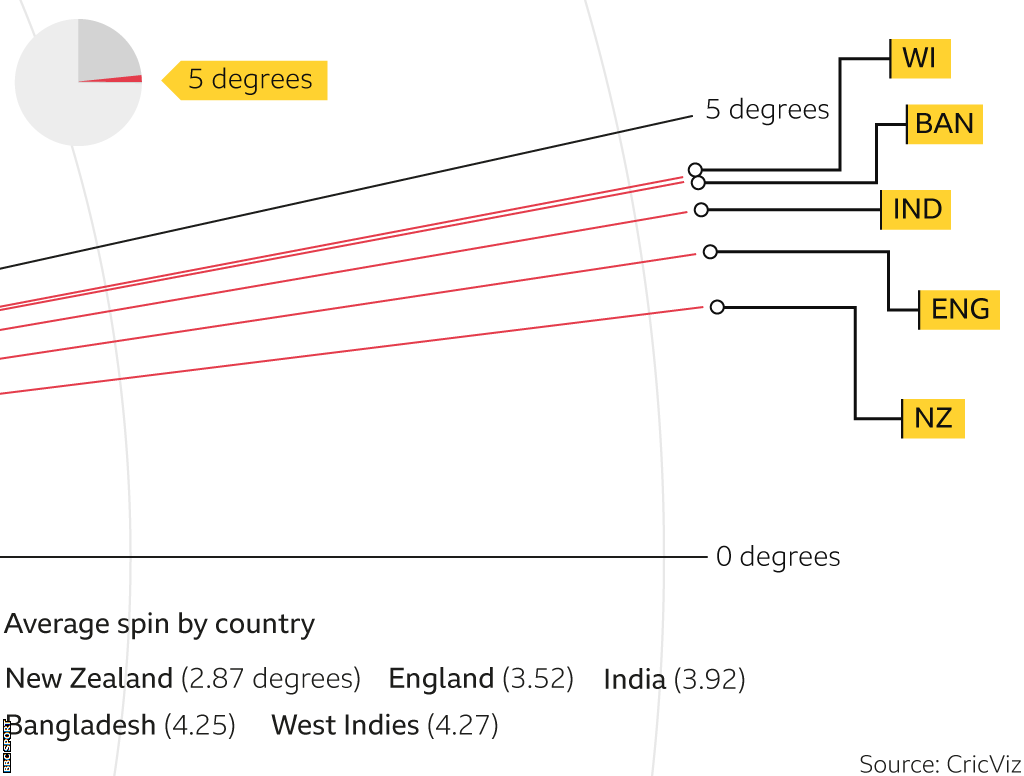Ashes: Is cricket the hardest sport to win away from home?
- Published
- comments

England have lost nine of their past 10 Tests in Australia
A version of this article was originally published on 10 January 2018.
"Attendances in Test cricket are going down because you know who is going to win before you turn up. There has to be jeopardy as to who wins the game. I'm a Newcastle fan and I turn up genuinely thinking they have a chance of winning every single game in the Premier League. They've not, but they have more of a chance than England had in Brisbane at the start of this Ashes series.
Perhaps former England spinner Graeme Swann has a point. Has Test cricket become too predictable?
Take England as an example. Their win-loss record at home since 2012 is 23-11 in their favour. Away from home it plummets to 23-7 in the opposition's favour.
That record looks like getting even worse after England were bowled out for 58 by New Zealand on day one of the first Test in Auckland on Thursday.
England have not lost an Ashes series at home since 2001. They have won outright only once in Australia since 1986-87.
After England fell to a 4-0 loss in their latest venture down under - coming on the back of a 5-0 rout in 2013-14 - Test Match Special's Ed Smith surmised: "I don't think this series leaves you with much optimism about this format. I am concerned about how predictable a lot of the cricket has been."
So has Test cricket's 'predictability' made it boring? And is cricket the hardest sport in which to win away from home?
Test cricket is actually no more predictable than it has ever been
While it is true that home teams hold the advantage in Test cricket - for a variety of reasons analysed below - it's not a new phenomenon.
The percentage of Test wins earned by visiting sides has not changed drastically over the years.
It has stayed between 20% and 30% for the past 100 or so years. If anything, away teams are winning more - victories for the touring sides in the 2010s is 27% compared to 23% in the 90s.
Take away the anomaly of just 6.8% of wins for the away side in the calendar year of 2013 and that figure rises even higher - to above 30%.
So what are the reasons for the home advantage?
There are many, but one of the most obvious is to do with pitches.
Put simply, the pitches in each of the 10 Test-playing nations offer a different challenge for both batsmen and bowlers.
In Australia and South Africa, the ball bounces more than it does anywhere else. Hence fast bowlers are king.

Calculations are from 2007 to present
In England, New Zealand and, perhaps surprisingly, India the ball swings away from the batsmen more - meaning bowlers of obvious skill are more desirable than out-and-out pacemen.

Calculations are from 2007 to present
In Asia and, in recent years, the West Indies, the ball grips and spins off the dry surface more. This magnifies the need for a top-class turner of the ball and batsmen with the skills to overcome that challenge.

Calculations are from 2007 to present
Former England batsman Graham Thorpe had success in all conditions and is now coaching the national team's one-day players, who have risen to fourth in the world rankings.
"Learning to adapt is one of the biggest things, and understanding what tweaks you have to make in different countries," said Thorpe, who scored Test hundreds, external in England, Australia, New Zealand, Pakistan, South Africa, Sri Lanka and West Indies.
"Sometimes, it's even just about looking at how the opposition batsmen score their runs. You'll notice that Australian and South African players play the cut and pull shot well because they are used to dealing with the ball which bounces more.
"In Asia, it's about how well you use your feet against spin bowlers and how well you gather your runs."
A different ball game

The Kookaburra and Duke balls
If playing on the world's different surfaces isn't challenging enough, a different ball manufacturer is used in Australia.
In England, Tests are played with a Duke ball, while a Kookaburra is used in Australia. Statistics seem to back up the widely held view that the Duke is more bowler-friendly.
When the English-produced Duke was used in domestic cricket in Australia, the average number of runs scored per wicket taken dropped from 34.6 to 28.9. The number of centuries scored per game also came down.
"Certain balls do perform better in certain conditions," said Australian Glenn McGrath, who has taken more Test wickets than any other fast bowler.
"I loved bowling with the Duke cricket ball - it felt smaller in the hand, had a bigger seam and would reverse swing a lot better. It was also harder than a Kookaburra so there were so many positives for the bowler."
However, McGrath added: "You have to adapt to different conditions around the world. I have no issues with having to adapt to different balls."
Fail to prepare, prepare to fail
It is also fair to say host nations are not as hospitable to visitors as they once were.
Tours are shorter, warm-up matches are fewer and the opposition provided by the hosts for such matches is often extremely weak.
Imagine the England football team preparing for a World Cup by allowing their group-stage opponents to pick their opposition.
Throw in the fact many nations - with the possible exception of Australia - produce pitches which suit their team, and it becomes an uphill task for touring teams.
How can you pass a tough exam without any serious revision?
"We have to draw a line under this tit-for-tat, zero-quality preparation that touring teams are given these days, which is totally against the interests of Test cricket," says BBC cricket correspondent Jonathan Agnew.
"Hopefully this has reached the depths and administrators have to realise they must give teams proper practice and preparation, otherwise touring sides are going to keep getting hammered.
"There's a pattern developing - there's no chance to restore confidence, no chance to restore form, no chance to get players who aren't playing in a Test match into any sort of condition or form. That's got to stop. This practice has to end."
When does a disadvantage become an excuse?
We've established England struggle in Australia and India, while India struggle in Australia and England. Such narratives play out across Test cricket.
So why isn't anything being done about it? After all, this is not a new trend.
"We obviously have to believe that the next time we come to Australia we can win," said assistant coach Paul Farbrace after England's latest Ashes loss.
"That means the planning has to start now. As much as we talk about conditions, we know we haven't played well enough. If you don't score first-innings runs, you struggle to stay in games.
"Australia have had three quality seamers and a good spinner, which has enabled them to keep the pressure on our batsmen."
Adding weight to Farbrace's theory is the statistic that England averaged 354 in their first innings on this tour, compared to 445 when they last won in Australia in 2010-11.
Thorpe added: "Cricket does have challenges which are unique but the strongest teams in the history of the game have enough in their armoury - like quality quick bowlers - to go and blow opposition sides away when they are touring."
The key then? Score big runs and bowl fast - something Australia managed all summer down under as Steve Smith plundered almost 700 runs on his own and his three seamers - Mitchell Starc, Josh Hazlewood and Pat Cummins, all capable of bowling in excess of 90mph - shared 66 wickets.
England, by comparison, failed to take 20 wickets in a single Test during the series. They also failed to reach 500 in any innings.
How much harder is it to win away in cricket compared to other sports?
There's some justification for saying that cricket is one of the hardest sports for away teams when you take into account the different pitches, balls and climates which players encounter.
It's also difficult from a more human perspective - England flew out to Australia on 28 October. Their final game on tour - including a Test series in New Zealand - ends in April.
Logic would suggest visiting teams would improve as they got used to the conditions, but that hasn't happened for England on their past two tours of Australia, where they have lost nine out of 10 Tests.
This bucks a trend researchers found in America, where the home team won 60% of matches at the start of World Series contests between 1924 and 1982. By the end of the series, that figure had dropped to 40%. Similar figures apply in the NBA during a similar period: 70% and 46%.
Rather like trying to compare players across generations, it is difficult to offer a definitive answer to the question of whether cricket is the hardest sport to win away in.
In a Harvard University study of the Premier League in 2008,, external which looked at 5,000 matches involving 50 different referees between 1992 and 2006, researcher Ryan Boyko came up with the equation that for every extra 10,000 people in the crowd, the advantage for the home team increases by 0.1 goals.
In a crowd of, say, 50,000, that can be significant. The same study also revealed that away teams scored fewer goals and gave away more penalties.

Is home advantage more significant in football than cricket?
However, similar research, external has shown there to be negligible advantage in basketball when comparing how a player performs when attempting a free throw, during NHL shootouts in ice hockey and conversion of penalty kicks in Germany's Bundesliga.
As with many questions in sport, it probably comes down to personal opinion but there is no doubt it is hard for English cricket teams to win in places like Australia and India.
But not, it should be said, impossible.
- Published8 January 2018

- Published8 January 2018
- Published8 January 2018
